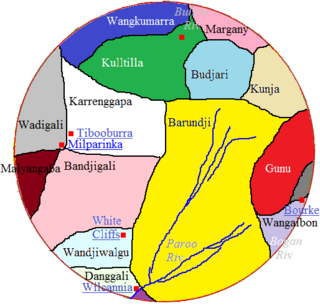Mythology
The origin story of the Minyungal concerns the legend of three brothers, each of whom established one of the tribes of the area. It tells of the arrival to this part of the eastern Australian coastline by 3 men/mythical culture heroes (Berruġ, Mommóm and Yaburóng)and their wives and children in a canoe.
Long ago, Berruġ together with Mommóm (and) Yabúrong came to this land. They came with their wives and children in a great canoe, from an island across the sea. As they came near the shore, a woman on the land made a song that raised a storm which broke the canoe in pieces, but all the occupants, after battling with the waves, managed to swim ashore. This is how 'the men' the paiġål black race, came to this land.The pieces of the canoe are to be seen to this day. If any one will throw a stone and strike a piece of the canoe, a storm will arise, and the voices of Berrúġ and his boys will be heard calling to one another, amidst the roaring elements. The pieces of the canoe are certain rocks in the sea.
At Ballina, Berrúg looked around and said, nyuġ? and all the paiġål about there say nyuġ to the present day. On the Tweed he said, ġando? (ngahndu)and the Tweed paigål say ġando to the present day. This is how the blacks came to have different dialects. Berrúġ and his brothers came back to the Brunswick River, where he made a fire, and showed the paiġål how to make fire. He taught them their laws about the kippåra, and about marriage and food. After a time, a quarrel arose, and the brothers fought and separated, Mommóm going south, Yaburóng west, and Berrúġ keeping along the coast. This is how the paiġål were separated into tribes.
This page is based on this
Wikipedia article Text is available under the
CC BY-SA 4.0 license; additional terms may apply.
Images, videos and audio are available under their respective licenses.

The Kangulu, also written Gangulu, is an aboriginal tribe from the Mount Morgan area in Queensland, Australia.
The Badjiri or Budjari, also written Badyidi, are an Australian Aboriginal people group of Queensland. They are not to be confused with the Pitjara.

The Warkawarka, or as preferred by the community Weki Weki, are an Australian Aboriginal tribe whose traditional lands are located in Victoria, Australia.
The Ngurunta or Runda are believed to have been an indigenous Australian people of the state of South Australia located immediately west of Lake Frome.
The Tulua were an indigenous Australian tribe of Queensland.
The Kwatkwat were an indigenous Australian tribe of the State of Victoria, though some scholars consider them part of the broader Yorta Yorta/Pangerang macrogroup.
The Kuungkari are an indigenous Australian people of Queensland. They are to be distinguished from the Kunggari.
The Wadja were an indigenous Australian people of Queensland.

The Karenggapa are an indigenous people of New South Wales. They might have spoken a dialect of the Yarli language, but there is little data.
The Bitjara or Bithara were an indigenous people of the state of Queensland. They spoke a dialect of the Ngura language. They are not to be confused with the Warrego River Pitjara or the Badjiri of the Paroo River.
The Maikathari (Mayi-Thakurti) were an indigenous Australian people of the state of Queensland.
The Koa (Guwa) are an indigenous Australian people of the state of Queensland.
The Ringaringa (Ringu-Ringu) were an indigenous Australian people of the state of Queensland.
The Yambina were an indigenous Australian people of the state of Queensland.
The Karingbal (Garaynbal) are an indigenous Australian people of the state of Queensland. They spoke a dialect of Biri.
The Arakwal were an indigenous Australian people of the state of New South Wales.
The Jeithi were an indigenous Australian people of the state of New South Wales.
The Kawambarai (Gawambaraay) were an indigenous Australian people of the state of New South Wales. Their domain was in the central–western district of New South Wales
The Wanjiwalku were an indigenous Australian people of the state of New South Wales.
The Wiyabal were an indigenous Australian people of the state of New South Wales.








